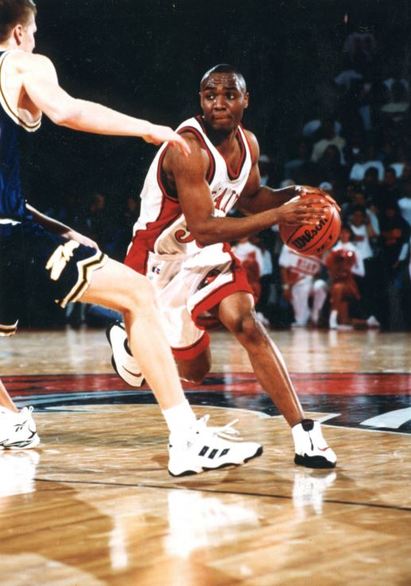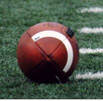 Damon Frierson's versatility proved particularly valuable in his junior season.
Damon Frierson's versatility proved particularly valuable in his junior season. They called him “Smooth,” but Damon Frierson’s journey to -- and through -- March Madness is a reminder that such a path is typically marked by twists, turns, peaks, valleys and a variety of unforeseen hazards.
This is the first of two articles on Frierson, a former Indiana “Mr. Basketball” who was inducted into the Miami Athletic Hall of Fame last December. As with the vast, vast majority of collegiate basketball players, his NCAA career ended on a loss. Along the way, however, “Smooth” was a key player for a Miami program that eventually reached the NCAA Sweet Sixteen.
Part I
It was former Miami and Central Michigan head coach Charlie Coles – also a Miami player back in the day – who first applied the nickname of “smooth” to Frierson. Coles was an assistant for MU at the time, but he . . .
. . . rose to the head coaching spot and guided his RedHawks to and through March Madness in Frierson’s senior year.
Frierson did things so well – and often in such an understated manner – that the “smooth” nickname seemed to fit on a number of levels. He even managed to win the Indiana “Mr. Basketball” title with a somewhat unspectacular average of about 20.0 points per game. Yet, as he would later prove at the collegiate level, his total game was a package of scoring, defense and team play. Stoking it all – beneath a quiet manner -- was the heart of a fierce competitor.
Frierson graduated from Ben Davis High School in Indianapolis, Indiana. He noted that the school is well-known for its football prowess, but it certainly was racking up wins on the hardwood during his time there. The Giants went 32-1, winning the first of two state basketball titles, in Frierson’s senior year. He averaged 20 points per game while taking an average of 14 shots per contest.
“Nowadays, I think Mr. Basketballs would average mid-20s, almost 30 (ppg),” Frierson said. But in addition to a change of basketball styles and some rules over time, there was another factor. “We had a very balanced team. Two of our inside players averaged 16 and 14, I believe, and they went on to play Division I, as well.”
Purdue had expressed interest in Frierson at one point, but it wanted a verbal commitment at the beginning of his junior year. “I decided to wait,” said Frierson, who liked the University of Kentucky style of play and was a fan of Jimmy Jackson at Ohio State. Miami University, coached by Herb Sendek at the time, also entered the picture and stuck with its recruitment when Frierson ran into some physical problems.
The first was a sprained ankle early in the post season tournament of his junior season. That significantly hobbled him during a major showcase time for high school athletes. He then sprained his other ankle, limiting his skills during AAU ball in the summer.
While some schools backed off, Sendek and Miami stuck with Frierson. It didn’t hurt that Sendek had been an assistant at Kentucky and was already enjoying some success at MU, which upset Arizona in NCAA tournament play the previous year, ”It was the first school I visited and the only school I visited,” Frierson said, noting a fall trip to Oxford.
Sendek and his coaches were also busy elsewhere, picking up commitments from Rob Mestas (Minnesota’s Mr. Basketball), Anthony Taylor out of Boston and a pretty good player from Long Island, New York – Wally Szczerbiak, among others. This new influx of talent joined a pretty talented group already in place.
“The first day on campus, we all went to the gym and played. I thought then that we could really be good. Wally was probably the best shooter that I had ever played against, because he was making everything.”
Frierson’s defensive focus and skills – honed by a high school coach who demanded execution in a many-to-man defensive system – were quickly recognized and contributed to Frierson’s early entry to Miami’s lineup.
“I wanted to come in and contribute right away. That summer I worked hard before classes started,” he said. “I wanted to be a starter and everything, but I knew if I focused at least on defense, I would get a shot at playing.”
Frierson started all 29 games and led the team in minutes (31.2 mpg). He averaged 11.1 ppg (third on team) and 3.4 rpg while playing both small forward and guard. Miami’s Freshman of the Year was also second on the team in free throw percentage (.842) giving another early indication of the many strengths Frierson brought to the court.
Frierson had another solid season as a sophomore, scoring 12.5 ppg , hitting 86.1 percent at the line (second best in MAC and shared team’s Defensive Player of the Year honors.
Despite the departure of Devin Davis, a key cog in Miami success at the time, Frierson and his class were optimistic about their junior campaign.
“We had played two years with Devin Davis, and it was kind of his team. Now that he had graduated, it was on us. We were looking forward to the challenge of being the –go-to guys.”
It would be a year of challenges for the team in general and Frierson in particular. First came a major injury (ACL) to point guard Rob Mestas during the summer. “he was probably the best on-the-ball defender that I played against,” Frierson said. “He was quick, and he was strong. He could get teams out of their offense.”
Beyond that, it forced the 6-3 Frierson over to the point guard spot.
“That was the first time that I played the one (spot) for extended minutes in my whole basketball career,” he recalled. Not only did it challenge his skill set, the move also proved to be a very tough physical challenge. Opponents quickly became aware there was no other real backup point guard available, and took advantage of the situation.
“Teams would game plan (to run me down and get me tired). It probably worked to some extent. My field goal percentage wasn’t the greatest … but I was still prideful and wanting to play my best.”
Miami fell at Tennessee, 75-74, in his first game at the point. That was followed by a double-overtime victory over Dayton to start a six-game winning streak.
Frierson’s challenges escalated in early January when Szczerbiak, who averaged 24.4 ppg that season) sustained a wrist injury in a game at Central Michigan. While MU won that game, it lost four of the next five.
At season’s end, Frierson owned a MAC-highest average of 38.3 minutes per game. “That was probably one of the hardest years for me physically,” he said. “Moving from a two or three (spot) to a one, from a physicality standpoint, I never knew it took that much out of you.” Moreover, “I was (trying) to run the offense and be a scorer at the same time.”
Szczerbiak returned at the end of January, and MU closed the regular season winning five of seven. The most shocking thing of the season, however, awaiting in the first round of MAC tournament play. Miami was at University Arena in Kalamazoo to face a Western Michigan team that registered a 63-47 win over MU on the same floor back in early January. Midway through the first period, Coles, who had a history of heart problems collapsed on the sideline.
(CONTINUED IN PART 2)


 RSS Feed
RSS Feed